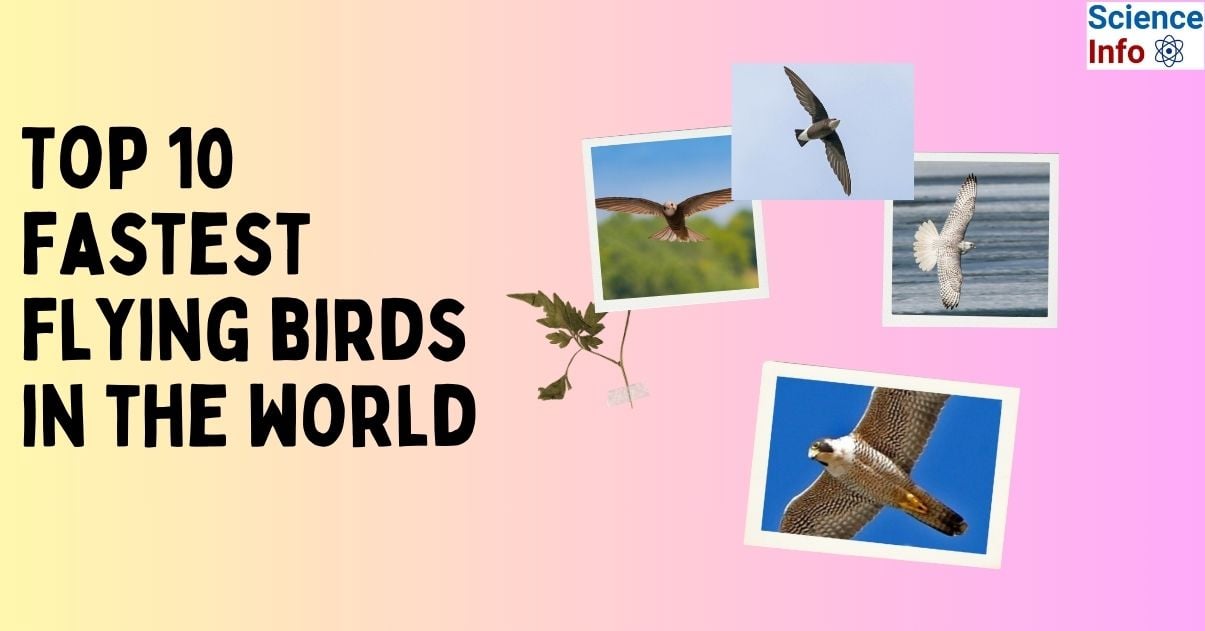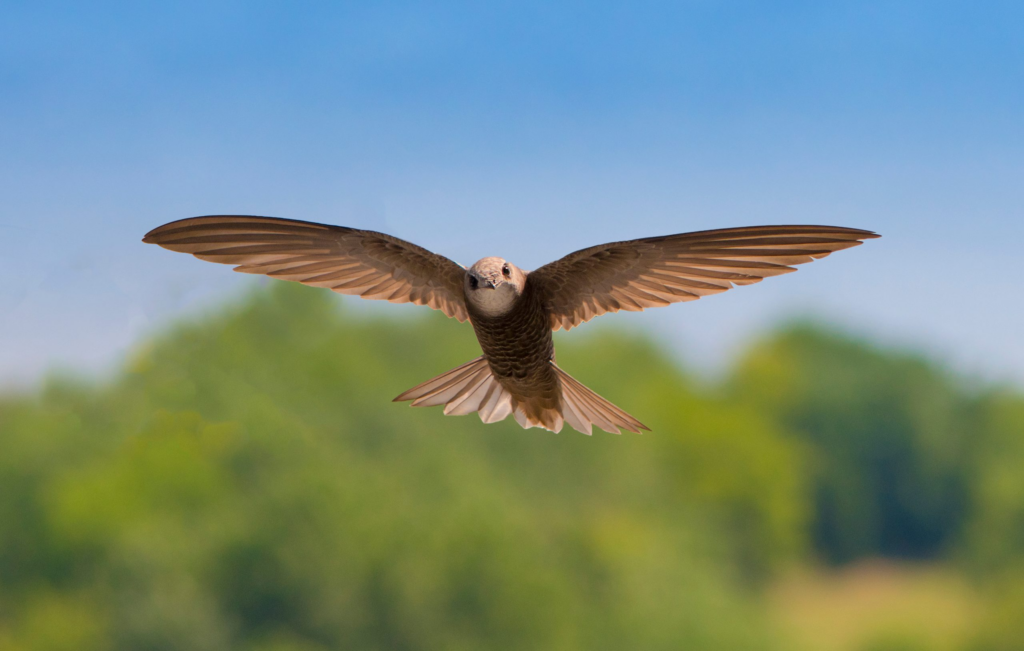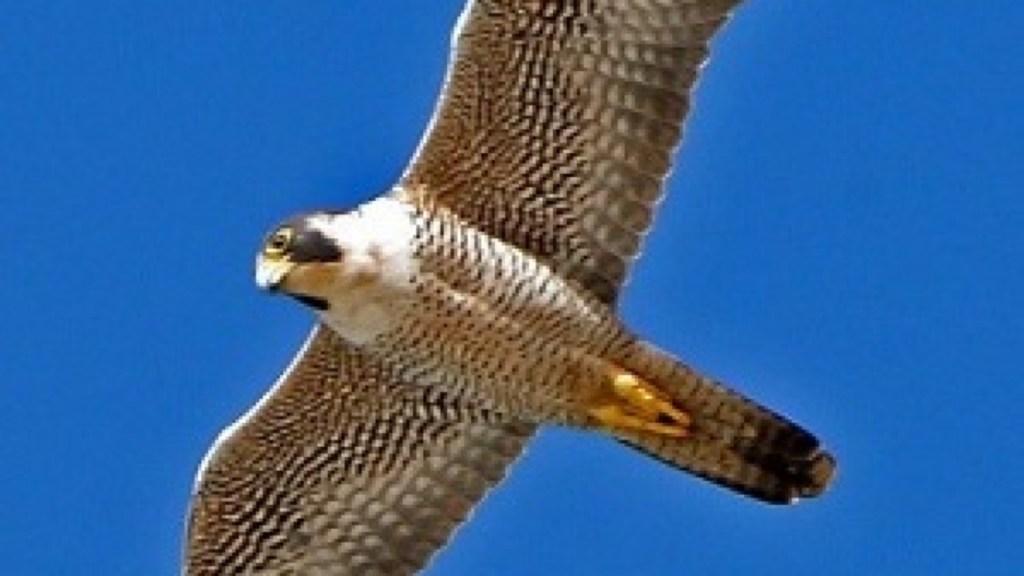Birds can be found in every continent of our planet. They are warm-blooded animals that belong to the class Aves. They are distinguished by their feathers, hard-shelled eggs, beaked jaws, high metabolic rates, four chambered hearts, and robust yet lightweight skeletons. They can be found in all shapes and sizes. The bee humming bird is the smallest bird, with a size of 5.5 cm, and the largest is the ostrich, with a massive size that can grow up to 2.8 m.

Over 11,000 bird species exist worldwide. They can be found in the hottest parts of the Sahara deserts as well as the coldest areas of Antarctica. Many birds have to migrate from one location to another in search of food, warmth, and breeding. Birds can travel thousands of miles across the continent. Month-long voyages from the middle of the oceans necessitate speed and agility. So, in this section of the article, we’ll look at the world’s fastest flying birds.
Interesting Science Videos
List of Fastest Flying Birds
You may have heard that the peregrine falcon is the fastest animal in the air, reaching speeds of about 389 km.ph / 242 mph. Although this is true, such unprecedented speed happens only during a quick descent or ‘stoop’ and is mainly driven by gravity and aerodynamics rather than flight. Some birds, such as the Winter Wren and Ruffed Grouse, fly slower and have rounder wings. These birds don’t fly as quickly since they don’t have to. Their rounded, less aerodynamic body and small wings are adaptations for surviving and flying through dense foliage. Nonetheless, they can fly swiftly, albeit briefly and over small distances.
Fast-flying birds are those that typically reside in open areas, move large distances, or forage in the air. These include birds such as falcons, sandpipers, and swifts. They all have long, pointed wings and aerodynamics bodies that allow them to fly effortlessly.
Let’s take a look into the list of fastest flying birds in the world.
10. Red Breasted Merganser
The red-breasted merganser (Mergus serrator) is a duck species native to the Northern Hemisphere. It has a long, thin crimson bill with serrated edges, as well as a spikey crest. The male features a black back, white underparts, a white neck with a rusty breast, and a dark head with a green sheen. Female adults have a grayish body and a reddish head. Although they have fewer white wing patches and lack white collar, young resemble females in appearance. Adults fly quickly and hunt by diving from the surface to follow aquatic species underwater, using hooked bills to grab slippery fish. Males only show the red breast that provides the species its popular name during their mating season.
- Size of Body: 51 – 64 cm.
- Wing Span: 66 – 74 cm.
- Weight: 800 – 1350 gm.
- Flight Speed: 130 km/h (81 mph)
Mergus is the only species in the genus that migrates from lake and river breeding areas to coastal wintering grounds every year. Apart from the breeding season, they form small flocks of up to 100 birds. Despite having a constant global population, this species is threatened in some areas due to habitat loss and other factors.

9. Spur-Winged Goose
A member of the Anatidae family, which also includes shelducks and geese, the spur-winged goose (Plectropterus gambensis) is a huge, Sub-Saharan, African water-bird. Open grasslands with lakes, seasonal pools, rivers, swamps, and river deltas are common habitats for this species. This widespread species rests by the water during the middle of the day after feeding by grazing. Its diet is mostly composed of plant material, including the seeds and vegetative sections of aquatic, sedge, and grass plants, as well as agricultural grains, fruit (like figs), and tuberous crops. Occasionally, it also consumes tiny fish or insects to expand its diet. The spur-winged goose is a social bird which generally congregates in small flocks of up to 50 individuals.
- Size of Body: 75 – 115 cm.
- Wing Span: 150 – 200 cm.
- Weight: 4 – 6.8 kg.
- Flight Speed: 143 km/h (89 mph)
Spur-winged geese can be poisonous in certain groups. Poisonous groups exist when blister beetles constitute a large portion of the diet. People who consume roasted geese will get poisoned due to the presence of the poison, cantharidin, in their tissues. Spur-winged geese have varying breeding seasons depending on where they live. Breeding season runs from August to December in the north, from January to June in eastern Africa, and from August to May in southern Africa.

8. Magnificent Frigatebird
The magnificent frigatebird (Fregata magnificens) is a seabird from the frigatebird family Fregatidae, which may be found in all tropical and subtropical oceans. It is the largest species of frigatebird. They have mainly black plumage, long, sharply forked tails, and a lengthy hooked beak. Females have white underbellies, while males have a unique red gular pouch that they inflate during the breeding season to lure females. Frigatebirds, which can soar for weeks on wind currents, spend the majority of their days in air foraging for food and roost at night on trees or cliffs. Their main diet is flying fish and squid, which they catch when large predators like tuna bring them towards the water’s surface.
- Size of Body: 89 – 114 cm.
- Wing Span: 2.17 – 2.44 m.
- Weight: 1.1 – 1.5 kg.
- Flight Speed: 153 km/h (95 mph)
Frigatebirds are recognized as kleptoparasites because they often steal other seabirds of their food and are known to steal seabird babies from their nests. The magnificent frigatebird population in the Galápagos Islands may require its own protection designation. This small group of genetically distinct magnificent frigatebirds is endangered. Any catastrophic occurrence or human threats could wipe off the estimated two thousand superb frigatebirds that nest on the Galápagos Islands. Frigatebirds are recognized as kleptoparasites because they often steal other seabirds of their food and are known to steal seabird babies from their nests.

7. Eurasian Hobby
The small, slender Eurasian hobby (Falco subbuteo), commonly referred to as hobby, is a type of falcon. Tops of adults are slate-grey, with two short black lines on the moustachial edge and a black crown. The lowermost parts are mostly white with black streaks, with the throat, thighs, and under tail converts becoming rufous. Views up close reveal the red “trousers” and vent. Both sexes are alike.
The young have streaked buffy thighs, under tail coverts, and scaled upper parts. They are typically much browner. It can catch huge insects, like dragonflies, with its swift and forceful flying, transferring them from talons to beak and consuming them as it circles slowly. It also catches little birds and bats in flight.
- Size of Body: 29 – 36 cm.
- Wing Span: 74 – 84 cm.
- Weight: 175 – 285 gm.
- Flight Speed: 159 km/h (99 mph)
This bird inhabits open areas including savannah, taiga, farms, and marshes. They are common on lowlands with sporadic pockets of dense forest. It is a stylish hunter that resembles a sickle in flight due to its long, pointed wings and square tail. When it glides with its wings folded, it frequently resembles a swift. Old crow and other nests of birds are used by hobby’s to build their nests. Usually, a tree in a hedge or at the very edge of a spinney is selected, allowing the bird to view visitors from a distance. It usually lays two to four eggs.

[Image source: https://www.kuwaitbirds.org/birds/eurasian-hobby]
6. Common Swift
The common swift (Apus apus) is a medium-sized bird that belongs to the Apodiform order. It resembles the barn swallow and house martin on its outer appearance, although it is somewhat larger and is not descended from those passerine species.
The closest relatives of common swifts are Southeast Asian treeswifts and hummingbirds. They appear fully blackish-brown, with the exception of a faint white or pale grey spot on their chins that is barely noticeable from a distance. They have a short forked tail and long, swept-back wings that resemble a crescent or a boomerang. They frequently create “screaming groups” during summer evenings, when 10-20 swifts join in flight near their nesting area, screaming out and being responded by other swifts.
- Size of Body: 16 – 17 cm.
- Wing Span: 38 – 40 cm.
- Weight: n/a
- Flight Speed: 165 km/h (103 mph)
Swifts form relationships forever and frequently revisit to the exact same nesting place with mate every year, fixing damage caused by their 40-week migration. Insects like clothing moths, carpet beetles, and pantry beetles may eat all but some inedible nest materials, which are often feather shafts. Young nesting swifts can survive several days without food by lowering their internal temperature and rate of metabolism, resulting in a torpid state. Apart from nesting, swifts spends all of their time in the air, eating insects captured in flight; they drink, feed, and frequently mate and sleep on their wings. Some individuals may stay as much as ten months without landing. No other bird spends the majority of its life in flight.

5. White-throated Needletail
The white-throated needletail (Hirundapus caudacutus), often referred to as needle-tailed swift or spine-tailed swift, is an enormous swift belonging to the Hirundapus genus. White-throated needletails are huge swifts with a sturdy, barrel-shaped body. Large swifts with a strong, barrel-like body are called white-throated needletails. With the exception of a white patch that runs from the base of the tail to the flanks and a throat, the entire body is grayish-brown. The spine-tipped tail of needle-tailed swifts—which is not split like that of normal swift’s in the genus Apus—gives them their name.
- Size of Body: 18 – 20 cm.
- Wing Span: 29 – 34 cm.
- Weight: 100 – 120 gm.
- Flight Speed: 168 km/h (105 mph)
White-throated needletails migrate, mating in southern Siberia and Central Asia and spending the winter south of the Indian Subcontinent, Southeast Asia, and Australia. In Western Europe, it is a rare wanderer that has been documented as far west as Norway, Sweden, and the United Kingdom. Their nests are built in tree cavities or crevices in the rock in cliffs. They prefer to be in the air the majority of the time and dislike spending time on the ground. They eat moths, flies, beetles, along with other small flying insects.

4. Gyrfalcon
Predatory in nature, the gyrfalcon (Falco rusticolus) is the largest falcon species. Due to its high degree of polymorphism, the gyrfalcon’s plumage varies widely. Although their colors range from completely white to dark in color, the classic morphs are known as “white,” “silver,” “brown,” and “black.” It exhibits sexual dimorphism, meaning that the female is significantly larger than the male, just like other falcons. People have regarded gyrfalcons as hunting birds for centuries. The gyrfalcon is the world’s largest falcon, around the same size as the largest buteos (buzzards), but probably notably heavier.
- Size of Body: 48 – 65 cm.
- Wing Span: 110 – 160 cm.
- Weight: 850 gm. – 1.75 kg.
- Flight Speed: 186 – 209 km/h (116 – 130 mph)
It feeds solely on mammals and birds, something it consumes more frequently compared to several other Falco species. It attacks horizontally, like most other hiero-falcons, unlike stooping from a height like the peregrine. The majority of prey gets killed on the ground, regardless of whether it was caught there or if the victim is a soaring bird forced to land. The gyrfalcon usually always nests on cliff walls. Breeding pairs do not build their own nests, instead relying on bare rock ledges or abandoned nests of other birds, mainly golden eagles and common ravens. The clutch size can range from one to five eggs, but it is often two to four. Gyrfalcons’ sole natural predators are golden eagles.

3. Golden Eagle
The golden eagle (Aquila chrysaetos), is a predatory bird. It is the eagle species which is widely distributed. It is an eagle and is a member of the Accipitridae family. These birds have darker brown bodies with lighter golden-brown nape plumage. This species’ young chicks commonly have white markings on their wings and a white tail. Some people believe that golden eagles are the finest fliers of any raptorial bird, possibly even better than other eagles. Their wings are large and broad, with indentations on the tips that resemble fingers. Among their genus, golden eagles are distinctive in that their wings are frequently kept in a small, upturned V-shape when they fly. This characteristic makes them unique.
- Size of Body: 66 – 102 cm.
- Wing Span: 1.8 – 2.34 m.
- Weight: 4.5 gm. – 6.75 kg.
- Flight Speed: 321 km/h ( 200 mph)
Golden eagles hunt a wide range of prey, primarily hares, rabbits, marmots, and other ground squirrels, using their agility, speed, strong feet, and enormous, pointed talons. The home grounds or territories of golden eagles can span up to 200 km2 (77 sq. mi). They may spend multiple mating years traveling to their enormous nests which they construct on cliffs or other elevated locations. Being monogamous, they can stay together for years or even for life, with the majority of breeding activities happening in the spring. During the course of a six-week period, females may lay up to four eggs. Approximately three months typically provides sufficient time for just a few young to survive and fly away.

2. Saker Falcon
The saker falcon (Falco cherrug Gray) is a big falcon species. Saker falcons typically have erratic feathering. Except for size, males and females are similar, as are juvenile birds, however the adults are usually darker and more strongly streaked. It reproduces from Central Europe all the way to Manchuria in the east throughout the Palearctic. It spreads its genes eastward, breeding all the way to Manchuria over the Palearctic. The population is not entirely migratory; rather, some members migrate while others do not. They journey across Pakistan, the Arabian Peninsula, and the Middle East, where they encounter unlawful entrapment. Hungary, the United Arab Emirates, and Mongolia have the saker falcon as their national bird.
- Size of Body: 45 – 57 cm.
- Wing Span: 97 – 126 cm.
- Weight: 730 gm. – 1.3 kg.
- Flight Speed: 325 km/h ( 202 mph)
The saker falcon is an expansive grassland raptor that prefers areas with sporadic trees or cliffs. Rather than stooping to hunt from a height like the peregrine, it frequently pursues prey horizontally and eats primarily rodents and birds. Feral pigeon and ground-nesting squirrels are the most prevalent prey in Europe. Instead of building a nest of its own, this species typically lays its three to six eggs in an abandoned stick nest in a tree that has previously been used by other birds like buzzards, storks, or ravens. It frequently builds nests on cliffs. The species is under threat from unlawful hunting, habitat degradation, and loss. The population of these birds was estimated to be anywhere between 7200 – 8000.

[Image source: https://nepaldesk.com/bird/saker-falcon]
1. Peregrine Falcon
The peregrine falcon (Falco peregrinus), sometimes referred to as just the peregrine or, historically, the duck hawk in North America, is a raptor from to the Falconidae family and a globally found predator. Its underparts have stripes of white, its scalp is black, and the back of it is blue-grey. The speed of the peregrine falcon is widely recognized.
Land areas from the Arctic tundra to the tropics are included in the peregrine’s nesting range. With the exception of the most tropical jungles, high alpine regions, and the extreme polar regions, it is present almost everywhere on Earth; the only significant ice-free landmass where it is completely absent is New Zealand. The outstanding hunting ability, high trainability, adaptability, and availability through captive breeding make the peregrine falcon a highly valued falconry bird.
- Size of Body: 34 – 58 cm.
- Wing Span: 74 – 120 cm.
- Weight: 330 gm. – 1.5 kg.
- Flight Speed: 389 km/h ( 242 mph)
While medium-sized birds make up the majority of the peregrine’s food, it occasionally hunts small animals, small reptiles, or even insects. After a year of reaching sexual age, it mates for life and builds its nest in a scrape, usually on cliff faces or, more recently, on big man-made buildings. earth while performing the stoop, which entails flying to a considerable height and then falling sharply at rates of over 389 km/h (242 mph), striking one of the wings of its prey so as not to damage itself on impact.
The peregrine falcon has become an endangered species in many locations due to the widespread usage of certain pesticides. The air pressure from such a dive may harm a bird’s lungs, but little bony tubercles on a falcon’s nostrils are thought to direct the intense airflow away from the nostrils, allowing the bird to breathe more freely while diving by decreasing the shift in air pressure.

[Image source: https://everyone.plos.org/2014/03/01/falcon-physics-science-diving-peregrine-falcons/]
Conclusion
Most of these speeds are based on researches done by some individuals and it does not imply the accuracy of speeds on every individual birds of the species. There are other different factors that can impact of the speeds such as migration, hunting, or trying to fly away from potential predators. Some individual can fly faster and achieve higher speeds than others. Who knows researchers out there may fight out some new exciting information in near future.
Also Don’t Forget to Check the list of
Top 10 Richest Countries in the World
Top 10 Poorest Countries in the World
Top 10 Happiest Countries in the World
Video Reference
Other References
- https://www.treehugger.com/fastest-birds-5070090
- https://www.thetravelalmanac.com/lists/birds-speed.htm
- https://dinoanimals.com/animals/the-fastest-birds-in-the-world-top-10/
- https://defenders.org/wildlife/peregrine-falcon
- https://www.britannica.com/animal/swift-bird
- https://www.guinnessworldrecords.com/world-records/fastest-bird-level-flight

